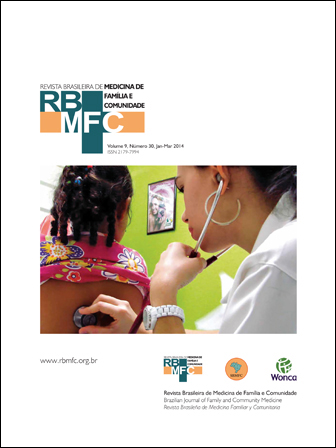Acne vulgar: diagnóstico e manejo pelo médico de família e comunidade
DOI:
https://doi.org/10.5712/rbmfc9(30)754Palavras-chave:
Acne vulgar, Terapêutica, Atenção Primária à SaúdeResumo
A acne vulgar é a doença cutânea mais frequente, afetando 85 a 100% da população em algum momento da vida; constituindo, por isso, um motivo frequente de consulta na atenção primária à saúde. Geralmente, tem início na puberdade, situando-se o pico de incidência entre os 14 e 17 anos nas adolescentes, e entre os 16 e 19 anos nos rapazes, sendo mais grave e prevalente no sexo masculino. Apesar de extensamente debatida, a acne vulgar requer uma atualização constante. Foi feita uma revisão das diretrizes clínicas, meta-análises e revisões sistemáticas publicadas nos últimos 15 anos, relacionadas à acne vulgar e seu tratamento. Esta patologia é normalmente dividida em três tipos clínicos: comedônica, pápulo-pustulosa e nódulo-cística. O diagnóstico é clínico, contudo outros diagnósticos diferenciais devem ser considerados. Das várias opções terapêuticas farmacológicas disponíveis, destacam-se os retinoides, os antimicrobianos e a terapêutica hormonal, cuja utilização deve ser ponderada, tendo-se em conta as suas indicações – tipo de acne e sua gravidade – e os seus efeitos colaterais. Assim, o médico de família e comunidade desempenha um papel de primeira linha na abordagem da acne vulgar, desde o diagnóstico à gestão das opções terapêuticas.
Downloads
Métricas
Referências
Figueiredo A, Massa A, Picoto A, Soares AP, Basto AS, Lopes C, et al. Avaliação e tratamento do doente com acne – Parte I: Epidemiologia, etiopatogenia, clínica, classificação, impacto psicossocial, mitos e realidades, diagnóstico diferencial e estudos complementares. Rev Port Clin Geral. 2011 Jan-Feb;27:59-65. DOI: https://doi.org/10.32385/rpmgf.v27i1.10821
Dréno B, Poli F. Epidemiology of Acne. Dermatology. 2003;206(1):7-10. http://dx.doi.org/10.1159/000067817 DOI: https://doi.org/10.1159/000067817
Thiboutot D, Gollnick H, Bettoli V, Dréno B, Kang S, Leyden JJ, et al. New insights into the management of acne: an update from the Global Alliance to improve outcomes in Acne group. J Am Acad Dermatol. 2009 May; 60(5 Suppl):S1-50. http://dx.doi.org/10.1016/j.jaad.2009.01.019 DOI: https://doi.org/10.1016/j.jaad.2009.01.019
Pawin H, Beylot C, Chivot M, Faure M, Poli F, Revuz J, et al. Physiopathology of acne vulgaris: recent data, new understanding of the treatments. Eur J Dermatol. 2004 Jan-Feb;14(1):4-12.
Carvalho A, Mourão A, Assunção C, Fonseca C, Gama D, Oliveira L, et al. Acne: prevalência e factores associados. Patient Care. Edição Portuguesa. 2010 Fev;15(156):59-65.
Mallon E, Newton J, Klassen A, Stewart-Brown SL, Ryan TJ, Finlay AY. The quality of life in acne: a comparison with general medical conditions using generic questionnaires. Br J Dermatol. 1999 Apr;140(4):672-6. http://dx.doi.org/10.1046/j.1365-2133.1999.02768.x DOI: https://doi.org/10.1046/j.1365-2133.1999.02768.x
Magin P, Pond D, Smith W, Watson A. A systematic review of the evidence for myths and misconceptions in acne management: diet, face-washing and sunlight. Fam Pract. 2005 Feb;22:62-70. http://dx.doi.org/10.1093/fampra/cmh715 DOI: https://doi.org/10.1093/fampra/cmh715
Gollnick H, Cunliffe W. Management of acne: general management strategies in acne. J Am Acad Dermatol. 2003 Jul;49(1):S30-1. DOI: https://doi.org/10.3109/9780203492642
Dunlap FE, Mills OH, Tuley MR, Baker MD, Plott Rt. Adapalene 0,1% gel for the treatment of acne vulgaris: its superiority compared to tretinoin 0,025% cream in skin tolerance and patient preference. Br J Dermatol. 1998 Oct;139(52):17-22. DOI: https://doi.org/10.1046/j.1365-2133.1998.1390s2017.x
Millikan LE. Pivotal clinical trials of adapalene in the treatment of acne. J Eur Acad Dermatol Venereol. 2001;15(3):19-22. DOI: https://doi.org/10.1046/j.0926-9959.2001.00008.x
Poli F. Soins cosmetiques et acne. Rev Prat. 2002 Avr15;52(8):859-62.
Hayashi N, Imori M, Yanagisawa M, Seto Y, Nagata O, Kawashima M. Make-up improves the quality of life acne patients without aggravating acne eruptions during treatments. Eur J Dermatol. 2005 Jul-Aug;15(4):284-7.
Chiu A, Chon SY, Kimball AB. The response of skin disease to stress: changes in the severity of acne vulgaris as affected by examination stress. Arch Dermatol. 2003 Jul;139(7):897-900. http://dx.doi.org/10.1001/archderm.139.7.897 DOI: https://doi.org/10.1001/archderm.139.7.897
Wolff K, Goldsmith LA, Katz SI, Gilchrest BA, Paller AS, Leffell DJ. Fitzpatrick’s Dermatology in General Medicine. 7th edition. New York: McGraw-Hill Medical; 2008.
Strauss J, Krowchuck D, Leyden J, Lucky AW, Shalita AR, Siegfried EC, et al. Guidelines of care for acne vulgaris management. J Am Acad Dermatol. 2007 Apr;56:651-63. http://dx.doi.org/10.1016/j.jaad.2006.08.048 DOI: https://doi.org/10.1016/j.jaad.2006.08.048
Wolff K, Johnson R, Suurmond R. Fitzpatrick Dermatologia - Atlas e Texto. 5a ed. Rio de Janeiro: McGraw-Hill; 2006.
Diepgen TL, Yihune G, Schuler G, Tanko Z, Lohrmann H, Paessler J et al. Dermatology Online Atlas. [acesso em 2013 Dez 9]. Disponível em: dermis.net
Katsambas AD, Stefanaki C, Cunliffe, WJ. Guidelines for treating acne. Clin Dermatol. 2004 Sep-Oct;22(5):439-44. http://dx.doi.org/10.1016/j.clindermatol.2004.03.002 DOI: https://doi.org/10.1016/j.clindermatol.2004.03.002
Williams HC, Dellavalle RP, Garner S. Acne vulgaris. Lancet. 2012 Jan;379(9813):361-72. http://dx.doi.org/10.1016/S0140-6736(11)60321-8 DOI: https://doi.org/10.1016/S0140-6736(11)60321-8
Figueiredo A, Massa A, Picoto A, Soares AP, Basto AS, Lopes C, et al. Avaliação e tratamento do doente com acne – Parte II: Tratamento tópico, sistémico e cirúrgico, tratamento da acne na grávida, algoritmo terapêutico. Rev Port Clin Geral. 2011 Jan-Feb;27:66-76. DOI: https://doi.org/10.32385/rpmgf.v27i1.10822
Martin-Zurro A, Cano Pérez JF. Atención Primaria. 5a ed. Madrid: Elsevier; 2003.
Feldman S, Careccia RE, Barham KL, Hancox J. Diagnosis and treatment of acne. Am Fam Physician. 2004 May; 69(9):2123-2130.
Ministério da Saúde (BR), Secretaria de Vigilância em Saúde. PORTARIA Nº 344, DE 12 DE MAIO DE 1998. Aprova o Regulamento Técnico sobre substâncias e medicamentos sujeitos a controle especial. Brasília, DF; 1988. Disponível em: http://bvsms.saude.gov.br/bvs/saudelegis../svs/1998/prt0344_12_05_1998_rep.html
Downloads
Publicado
Como Citar
Edição
Seção
Licença
Ao submeterem um manuscrito à RBMFC, os autores mantêm a titularidade dos direitos autorais sobre o artigo, e autorizam a RBMFC a publicar esse manuscrito sob a licença Creative Commons Atribuição 4.0 e identificar-se como veículo de sua publicação original.














